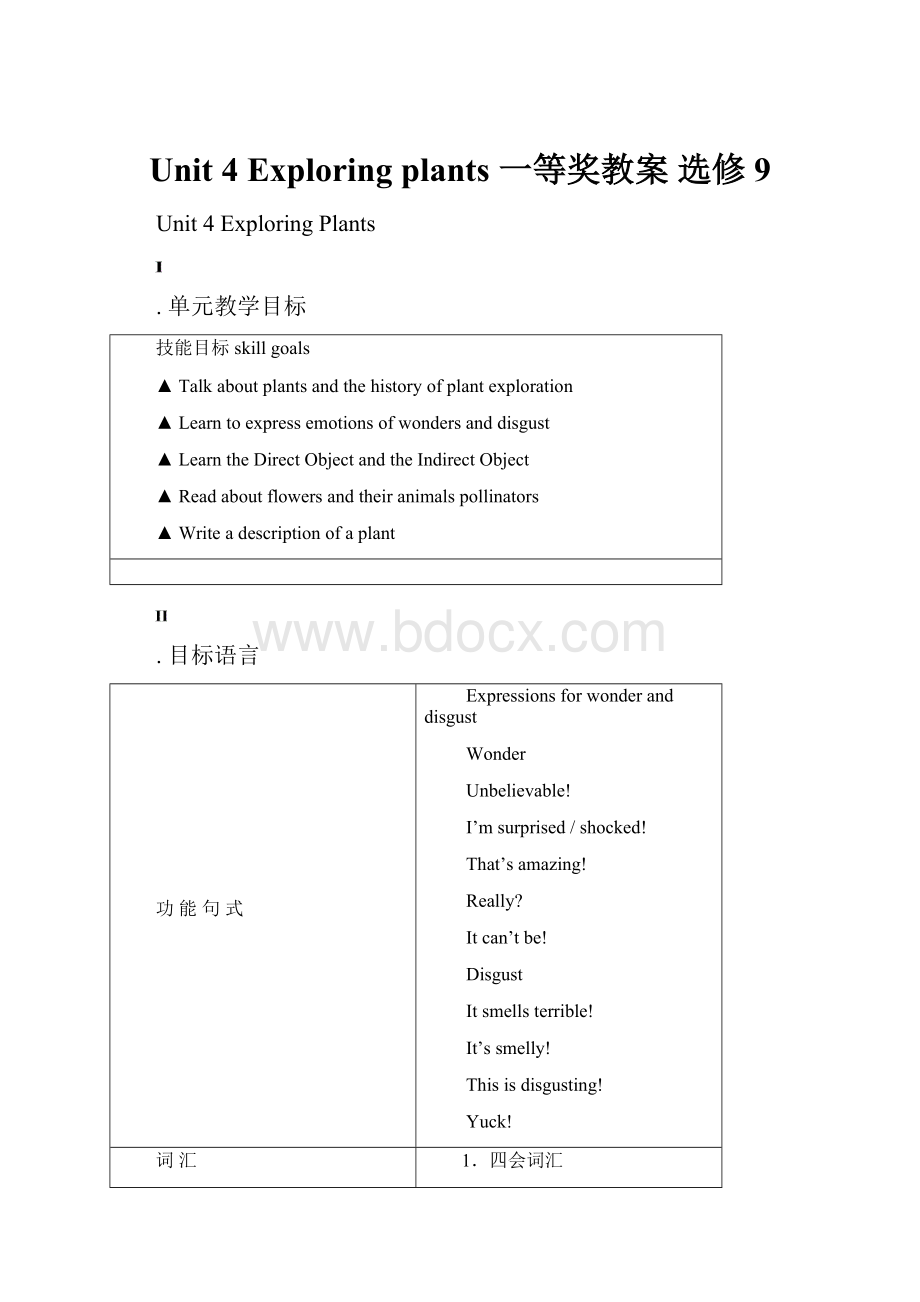Unit 4 Exploring plants 一等奖教案 选修9.docx
《Unit 4 Exploring plants 一等奖教案 选修9.docx》由会员分享,可在线阅读,更多相关《Unit 4 Exploring plants 一等奖教案 选修9.docx(47页珍藏版)》请在冰豆网上搜索。

Unit4Exploringplants一等奖教案选修9
Unit4ExploringPlants
.单元教学目标
技能目标skillgoals
▲Talkaboutplantsandthehistoryofplantexploration
▲Learntoexpressemotionsofwondersanddisgust
▲LearntheDirectObjectandtheIndirectObject
▲Readaboutflowersandtheiranimalspollinators
▲Writeadescriptionofaplant
.目标语言
功能句式
Expressionsforwonderanddisgust
Wonder
Unbelievable!
I’msurprised/shocked!
That’samazing!
Really?
Itcan’tbe!
Disgust
Itsmellsterrible!
It’ssmelly!
Thisisdisgusting!
Yuck!
词汇
1.四会词汇
pollinate,courtyard,balcony,exotic,distant,Egypt,goods,botanist,scale,conflict,endeavor,anchor,tight,tightly,seal,container,restriction,fluency,shave,thunderstorm,pirate,appeal,dove,lower,beard,ripe,irrigation,weed,spear,string,spade,postpone,pyramid,monument,rot,nectar,bat,evolve,evolution,attach,moth,wasp,beetle,typical,petal,tube,delicate,fragrant,daisy,odor,odorless,dull,musty,fruity
2.认读词汇
pollinator,missionary,d’Incarville,Joseph,NathanielWard,Wardiancase,FatherFarges,chrysanthemum,reddate,pitcher,Rafflesiaarnoldii,humming-bird
3.词组
datebackto,appealto,attachto,giveout
4.重点词汇
pollinate,exotic,distant,botanist,tightly,container,evolve,evolution,attach,typical,delicate,fragrant,odor,odorless
结构
1.Directobjectandindirectobject
2.–ingformortheinfinitiveastheobject
重点句子
1.Collecting“exotic”plants,astheyarecalled,datesbacktotheearliesttimes.P32
2.AnimportantgroupofcollectorswereFrenchCatholicmissionarieswho,bythemiddleif
the18thcentury,werebeginningtosetthemselvesupinChina.P32
3.SirBankswasaveryfamousBritishplantcollectorwhoaccompaniedJamesCookonhisfirstvoyagefromEnglandtoOceania.P32
4.TheworldofplantexplorationwascompletelychangedwithDrNathanielWard’s
inventionofatightlysealedportableglasscontainer.P32
5.Thisinvention,calledtheWardiancase,allowedplantstobetransportedonlongjourneys.
P32
6.Pollenbecomesattachedtotheanimalduringitsvisittoaflowerandisthenpassedontoanotherplant’sblossomonitsnextvisit.P38
7.Throughevolution,mostflowershaveadaptedtoattractspecifictypesofpollinators.P38
8.Thiskindofevolutionwheretwospecieshavebecometotallydependentoneachotheriscalledco-evolution.P78
Ⅲ.教材分析与教材重组
1.教材分析
本单元的话题是“植物和植物采集的历史”,通过单元学习,学生将了解一些植物学的常识、18和19世纪西方植物采集的历史、一些奇异的植物及授粉知识。
学生在听、说、读、写等技能训练的基础上,将了解植物对人类的重要意义和植物学家对不同植物种类在全世界的传播所做的贡献,从而培养对植物的兴趣,并能树立爱护植物、保护热带雨林的良好意识。
1.1Warmingup是本单元的热身活动,列出了几个有关植物的问题,要求学生回答这些问题,然后小组交流,分享对问题中提到的植物的了解,并能说出一些特殊的植物,从而引发学生对植物这一领域的兴趣。
1.2Pre-reading是阅读的热身,要求学生结合自己的生活实际回答几个问题,并激发他们了解更多有关植物知识的欲望,例如“植物是如何从一个地方漂流越洋到另一个地方?
”等。
另外,还要求学生根据文章标题和插图预测文章的内容,为后面的阅读做了充分的铺垫。
1.3Reading是一篇有关十八、十九世纪植物学研究和探索的文章。
该文章介绍了植物收集历史的起源,并介绍了西方历史上几位著名的植物学家以及他们对植物学研究所做的贡献。
1.4Comprehending设计了四个活动,检验学生对课文内容理解:
1要求学生分析各段落大意,并用自己的语言写出每段的主题;2列出了一些日期,要求学生运用找读技巧找出每个日期所发生的历史事件;3要求学生分组讨论一些问题,检验他们对文章一些细节的理解;4是一个小组活动,要求学生四人一组进行角色扮演,其中一个是船长,其他三个是植物学家,三个植物学家将分别向船长介绍他们各自选择的植物的种种好处,说服船长把他的植物带回本国去。
该活动是对文章内容的一个拓展,训练学生应用知识的能力和口语表达能力。
1.5LearningaboutLanguage包括两部分:
Discoveringusefulwordsandexpressions要求学生运用课文中的单词或短语填空,帮助学生在语境中学习、运用所学词汇;Revisingusefulstructures是语法学习,帮助学生掌握直接宾语和间接宾语的用法以及动名词或不定式做宾语。
1.6UsingLanguage包括三部分:
Listeninganddiscussing是关于三个特殊植物的听力和讨论活动,要求学生先根据三个植物的照片分别描述这三种植物,并能把名字和各个植物联系起来。
然后听录音完成表格,了解三种植物的名字及其由来、味道、形状、大小、生长地、叶子形状、食物来源,是否常见以及授粉情况等。
通过听录音材料,学生也将学会如何以及从哪些方面来描绘一种植物。
另外,学生还将通过录音材料学到描述惊异和恶心两种不同反应的词汇和表达法,并能分组会话,用这些词汇表达对一些不寻常事物的反应。
Writing是一个写作训练,要求学生根据一个图示,用所学的词汇和方法写一段对大王花的描述文字。
Readinganddiscussing提供了一篇阅读文章,主题是花和它们的虫媒,介绍了不同特点的花会有不同的虫媒。
要求学生在读懂课文的基础上,讨论图片中的哪些花需要哪些虫媒来授粉,并能给出理由,即是对阅读理解的检验,也是对所学知识和语言的综合应用。
1.7SUMMINGUP是对本单元所学知识和技能的总结,主要包括以下几个方面:
学生了解到的植物、最感兴趣的事物、有用的单词和短语以及识别不同类型的宾语。
1.8LEARNINGTIP建议学生通过搜集不同类型的文章来了解不同类型的文章体裁,并以本单元的文章为例,介绍了如何写一篇类似“18、19世纪的植物探险”的文章。
2.教材重组
2.1将Warmingup、Pre-reading、Reading以及Comprehending整合在一起,设计为一节“精读课”。
2.2将LearningaboutLanguage以及Workbook中的USINGWORDSANDEXPRESSIONS和USINGSTRUCTURES整合起来,上一节“语言学习课”。
2.3将UsingLanguage中的Listeninganddiscussing和Writing整合起来,上一节“综合技能课
(一)”。
2.4将UsingLanguage中的Readinganddiscussing以及Workbook中的READINGTASK整合在一起,上一节“泛读课”。
2.5将Workbook中的LSTENING和TALKING整合成一节“听说课”。
2.6将Workbook中的LISTENINGTASK、WRITINGTASK、SPEAKINGTASK以及PROJECT整合在一起,上一节“综合技能课
(二)”。
3.课型设计与课时分配(共6课时)
1stPeriodIntensivereading
2ndPeriodLanguagestudy
3rdPeriodIntegratingskills(Ⅰ)
4thPeriodExtensivereading
5thPeriodListeningandspeaking
6thPeriodIntegratingskills(Ⅱ)
Ⅳ.分课时教案
TheFirstPeriodIntensivereading
Teachinggoals教学目标
1.Targetlanguage目标语言
a.重点词汇和短语
explore,exploration,courtyard,balcony,distant,goods,conflict,anchor,tightly,container,restriction,fluency,shaving,thunderstorm,appealto,datebackto
b.重点句子
1.Collecting“exotic”plants,astheyarecalled,datesbacktotheearliesttimes.
2.AnimportantgroupofcollectorswereFrenchCatholicmissionarieswho,bythemiddleofthe18thcentury,werebeginningtosetthemselvesupinChina.
3.SirJosephBankswasaveryfamousBritishplantcollector.WhoaccompaniedJamesCookonhisfirstvoyagefromEnglandtoOceania.
4.TheworldofplantexplorationwascompletelychangedwithDrNathanielWard’sinventionofatightlysealedportableglasscontainer.
5.Thisinvention,calledtheWardiancase,allowedplantstobetransportedonlongjourneys.
2.Abilitygoals能力目标
Learnaboutthehistoryofplantsexplorationinthe18thand19thcentury.
Learnthemeaningsorusagesofthetargetwords,expressionsandsentences.
3.Learningabilitygoals学能目标
Helpthestudentslearnhowtosortoutthehistoricaleventsaccordingtotimesequence.
Teachingimportantanddifficultpoints教学重难点
Helpthestudentshaveaclearideaofthewholepassagebysummarizingthetopicofeachparagraph.
Teachingmethods教学方法
Scanning,skimming,question-and-answerandgroupwork.
Teachingaids教具准备
Projector,slideandtaperecorder.
Teachingprocedures&&ways教学过程与方式
StepⅠLead-in
T:
Aswealwayssay,animalsarehumans’goodfriends.Whilebesidesanimals,humansalsohaveothergoodfriends—plants.Don’tyouthinkso?
Canyoubelieveaworldwithoutplants?
Notrees,noflowers,nograss...Youmayhavefoundthatmoreandmorepeoplerealizetheimportanceofplantstoushumansandourenvironment,andmanymeasureshavebeentakentoprotectplants.Butwhatonearthdoplantsbenefitus?
Orwhataretheimportantthingsplantsprovide?
Makealistaccordingtoyourunderstanding.
Teachercanguidethestudentstoanswerthequestionfromthefollowingaspects:
Aesthetics(美学),Medicine,Food,Industrialproducts,Recreation,Airquality,Waterquality,Climate,FishandwildlifeHabitat(栖息地),Ecosystemandsoon.
Thisbrainstormingactivitywillhelpthestudentsgetanoverallknowledgeofplantsandtheirimportance.
Encouragethestudentstosaysomethingabouteachaspect.
StepⅡWarmingUp
GetstudentstalkaboutwhattheyknowaboutplantsandtalkaboutthequestionsinWarmingup.
T:
Wecan’tlivewithoutplants,right?
Weeattheirfruits,usewoodtobuildhouses,growbeautifulflowersinourhousesandmostimportantly,plantsproduceoxygen.Butwhatdoyouknowaboutplants?
NowturntoPage31.ReadthequestionsinWarmingupactivity.
Givestudentsseveralminutestodiscussthesequestions.Thenletthemreportwhattheyknowabouttheplantsmentioned.
Suggestedanswerstothesequestions:
1.Fern,algae(藻类植物),moss...
2.Orchids,bromeliads,vine,ferns...
3.Pitcherplant(猪笼草),sundew,bladderwort,Venusflytrap...
4.Appletree,sunflower,tulips,orchid,alfalfa(紫花苜蓿)etc.
5.Vine(藤本植物),Chinesedodder(菟丝子)...
6.Plantsareadaptedtoliveinspecificenvironment.Forexample,mosslivesinmoistanddarkenvironment.Rose,peony,jasmine,Chineseplum,chrysanthemumgrowwellinsunshine.Ifyouputthemindampandcoldenvironment,theywillnotblossomorevendie.
7.Yes.
8.Non-seedplants:
藻类(Algae),地衣(Lichens),真菌(Fungi),苔纲(Hepaticae),藓纲(Musci),蕨类(Pteridophyte),植物门(Pteridophyta)
StepⅢReadingcomprehending
LetstudentsanswerthequestionsinPre-readingtogetpreparedforthetext.
T:
Weknowthatmanyfamiliesgrowplantsattheirhomes.Generallywecallthempotplantsbecausetheseplantsaregrowninpots.Wheredomostpeopleputthesepots?
...Yes,onthebalconywherethereisenoughsunshine.Asyouknow,onlyafewfamilieshavecourtyardgardeninChina.
Helpstudentsunderstandthemeaningsofcourtyardandbalconybyshowingthemsomepicturesorgivesomeexplanations.
courtyard:
anopenspacethatiscompletelyorpartlysurroundedbybuildings.
balcony:
astructurethatyoucanstandon,thatisattachedtotheoutsidewallofabuilding,abovegroundlevel.
T:
Hasyourhousegotabalcony?
Doyouhavesomepotplantsonyourbalcony?
Whatarethey?
S:
Yes,myhousehasgotabigbalcony.Mymothergrowskaffirlily(君子兰),azalea(杜鹃),cactus(仙人掌),Chlorophytumcomosum(吊兰).
S:
Mymothergrowspeony(牡丹),asparagusfern(文竹)andsagocycas(铁树).
T:
Wheredotheseplantscomefrom?
AretheyChineseplantsordotheycomefromothercountrties?
Haveyouthoughtaboutthat?
Askstudentsthequestionsonebyonetoarousetheirinterestintheoriginofplants.
T:
NowturntoPage32.Scanthetitleofthepassageandpictures.Canyoutellwhatthepassageisabout?
S:
Ithinkittellsusaboutsomebotanistsinhistory.
S:
Ithinkittellsaboutthetravelofsomeplantsinthe18thand19thcenturies.Orinanotherword,howsomeplantstravelfromonecountrytoanother.
T:
Yes.Here“exploration”meanstheactoftravellingthroughaplaceinorderto